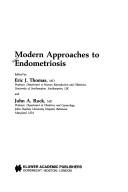| Listing 1 - 7 of 7 |
Sort by
|
Periodical
Abstract | Keywords | Export | Availability | Bookmark
 Loading...
Loading...Choose an application
- Reference Manager
- EndNote
- RefWorks (Direct export to RefWorks)
Endometriosis --- Endometrioma --- Endometriomas --- Endometrioses --- Endometriosis.

ISBN: 0792389018 9401057192 9401138648 Year: 1991 Publisher: Dordrecht Kluwer
Abstract | Keywords | Export | Availability | Bookmark
 Loading...
Loading...Choose an application
- Reference Manager
- EndNote
- RefWorks (Direct export to RefWorks)
Endometriosis. --- Endometriosis --- Endométriose --- Adenomyosis --- Endometrium --- Generative organs, Female --- Pelvis --- Endometrioma --- Endometriomas --- Endometrioses --- Diseases --- Endométriose

ISBN: 0929858484 9780929858487 1850702977 9781850702979 Year: 1990 Publisher: Carnforth Parthenon Pub. Group
Abstract | Keywords | Export | Availability | Bookmark
 Loading...
Loading...Choose an application
- Reference Manager
- EndNote
- RefWorks (Direct export to RefWorks)
Endometriosis --- ENDOMETRIOSIS --- Congresses. --- congresses. --- Endometrioma --- Endometriomas --- Endometrioses --- Conferences - Meetings --- Adenomyosis --- Endometrium --- Generative organs, Female --- Pelvis --- Congresses --- Diseases
Periodical
ISSN: 22840273 Year: 2013 Publisher: Milano : Thousand Oaks, CA : Wichtig Editore Medical Publisher, Sage Publications
Abstract | Keywords | Export | Availability | Bookmark
 Loading...
Loading...Choose an application
- Reference Manager
- EndNote
- RefWorks (Direct export to RefWorks)
Endometriosis. --- Pelvic Pain. --- Pain, Pelvic --- Pains, Pelvic --- Pelvic Pains --- Endometrioma --- Endometriomas --- Endometrioses --- Endometriosis --- Adenomyosis --- Endometrium --- Generative organs, Female --- Pelvis --- Diseases --- Pelvic pain. --- Pain

ISBN: 1912776006 1903734207 Year: 2003 Publisher: [Place of publication not identified] Health Press
Abstract | Keywords | Export | Availability | Bookmark
 Loading...
Loading...Choose an application
- Reference Manager
- EndNote
- RefWorks (Direct export to RefWorks)
Despite much research and many recent advances in management, endometriosis remains a major threat to the physical and psychological health of millions of women worldwide. Misdiagnosis is the major cause of prolonged and unnecessary suffering and 'Fast Facts: Endometriosis' specifically focuses on the timely and accurate diagnosis of the disease, presenting gynaecologists and healthcare physicians with the very latest facts to enable them to treat their patients with consideration and speed. • Provides an excellent overview of the epidemiology and pathogenesis of endometriosis including specific risk factors and the most recent results of randomised trials • Includes an expert review of endometriosis and infertility and highlights areas of controversy • Expert advice on diagnosis including ultrasound and MRI scanning • Offers comprehensive coverage of the medical treatment of endometriosis Contents: • Epidemiology and pathogenesis • Endometriosis and infertility • Diagnosis of endometriosis • Medical treatment of endometriosis • Surgical treatment of endometriosis • Treatment of infertility associated with endometriosis • Assisted reproductive technology and endometriosis • Extrapelvic endometriosis • Recurrent endometriosis • Adenomyosis • The doctor-patient partnership
Endometriosis --- Genital Diseases, Female --- Female Urogenital Diseases --- Female Urogenital Diseases and Pregnancy Complications --- Diseases --- Female Genitourinary Diseases --- Female Genitourinary Disease --- Female Urogenital Disease --- Genitourinary Disease, Female --- Genitourinary Diseases, Female --- Urogenital Disease, Female --- Urogenital Diseases, Female --- Female Genital Diseases --- Gynecologic Diseases --- Diseases, Female Genital --- Diseases, Gynecologic --- Female Genital Disease --- Genital Disease, Female --- Gynecologic Disease --- Gynecology --- Endometrioma --- Endometriomas --- Endometrioses
Book
Year: 2021 Publisher: Basel, Switzerland MDPI - Multidisciplinary Digital Publishing Institute
Abstract | Keywords | Export | Availability | Bookmark
 Loading...
Loading...Choose an application
- Reference Manager
- EndNote
- RefWorks (Direct export to RefWorks)
Minimally invasive surgery has become a common term in visceral as well as gynecologic surgery. It has almost evolved into its own surgical speciality over the past 20 years. Today, being firmly established in every subspeciality of visceral surgery, it is now no longer a distinct skillset, but a fixed part of the armamentarium of surgical options available. In every indication, the advantages of a minimally invasive approach include reduced intraoperative blood loss, less postoperative pain, and shorter rehabilitation times, as well as a marked reduction of overall and surgical postoperative morbidity. In the advent of modern oncologic treatment algorithms, these effects not only lower the immediate impact that an operation has on the patient, but also become important key steps in reducing the side-effects of surgery. Thus, they enable surgery to become a module in modern multi-disciplinary cancer treatment, which blends into multimodular treatment options at different times and prolongs and widens the possibilities available to cancer patients. In this quickly changing environment, the requirement to learn and refine not only open surgical but also different minimally invasive techniques on high levels deeply impact modern surgical training pathways. The use of modern elearning tools and new and praxis-based surgical training possibilities have been readily integrated into modern surgical education,which persists throughout the whole surgical career of modern gynecologic and visceral surgery specialists.
Medicine --- ovarian cancer --- laparoscopy --- minimally invasive surgery --- survival --- mortality --- platelet-rich plasma (PRP) --- thin endometrium --- hysteroscopy --- robotic surgery --- sexuality --- laparoscopic hysterectomy --- learning curve --- quality of life --- counseling --- patient-doctor-relationship --- body donors --- surgical education --- clinical anatomy --- live surgery events --- neuropelveology --- LION procedure --- genital nerves stimulation --- chronic pelvic pain --- esophagectomy --- esophageal cancer --- Ivor-Lewis procedure --- health-related quality of life --- cervical cancer --- robotic radical hysterectomy --- recurrence rate --- surgery --- artificial intelligence --- machine learning --- augmented reality --- hysterectomy --- NOTES --- minimally invasive --- systematic review --- meta-analysis --- pediatric surgery --- fetal surgery --- single-incision surgery --- surgical techniques --- surgical devices --- open surgery --- endoscopy --- endoscopic surgery --- cysts of the canal of Nuck --- Nuck hydrocele --- hydrocelectomy --- TAPP --- Lichtenstein --- colorectal liver metastases --- laparoscopic liver surgery --- minimal invasive surgery --- general anesthesia --- anesthetics --- perioperative care --- laparoscopic surgery --- endometrial cancer --- lymphadenectomy --- embryology --- sentinel lymph node mapping --- indocyanine green --- PMMR --- technical aspects --- rectal cancer --- mesorectal --- transanal --- laparoscopic --- local recurrence --- conversion rate --- minimally invasive surgical procedures --- radiotherapy --- ovarian neoplasms --- endometrial neoplasms --- uterine cervical neoplasms --- vaginal neoplasms --- vulvar neoplasms --- survival analysis --- video feedback --- video modeling --- gynecology --- surgical training --- pelvitrainer --- prolapse --- pelvic floor --- native tissue --- pectopexy --- robotic assisted surgery --- pancreatic surgery --- pancreaticoduodenectomy --- pelvic floor repair --- laparoscopic repair --- vaginal repair --- mesh use --- VATS --- pain --- postoperative pain control --- thoracic surgery --- lung cancer --- intercostal catheter --- opioid --- regional anaesthesia --- hepatectomy --- single-port laparoscopy --- radiofrequency pre-coagulation --- endometriosis --- endometrioma surgery --- ovarian reserve --- anti-Müllerian hormone --- spontaneous pregnancy --- robotic liver resection --- da Vinci --- intraoperative imaging --- hepatocellular cancer --- real-life imaging --- hepatic metastasis --- COVID-19 --- sars-cov-2 --- surgical performance --- 3D printing --- skill assessment --- snorkel mask --- malabsorption --- Roux-en-Y gastric bypass --- one-anastomosis gastric bypass --- SADI-S --- biliopancreatic diversion --- weight regain --- hepatocellular carcinoma --- cholangiocarcinoma --- risk score --- pelvic compartments --- embryologic development --- oncologic surgery --- pelvic lymphonodectomy --- topographic anatomy --- autonomic pelvic nerves --- uterine cancer --- prostate cancer --- diaphragmatic hernia --- liver resection --- hernia repair --- mesh --- enterothorax --- ovarian cancer --- laparoscopy --- minimally invasive surgery --- survival --- mortality --- platelet-rich plasma (PRP) --- thin endometrium --- hysteroscopy --- robotic surgery --- sexuality --- laparoscopic hysterectomy --- learning curve --- quality of life --- counseling --- patient-doctor-relationship --- body donors --- surgical education --- clinical anatomy --- live surgery events --- neuropelveology --- LION procedure --- genital nerves stimulation --- chronic pelvic pain --- esophagectomy --- esophageal cancer --- Ivor-Lewis procedure --- health-related quality of life --- cervical cancer --- robotic radical hysterectomy --- recurrence rate --- surgery --- artificial intelligence --- machine learning --- augmented reality --- hysterectomy --- NOTES --- minimally invasive --- systematic review --- meta-analysis --- pediatric surgery --- fetal surgery --- single-incision surgery --- surgical techniques --- surgical devices --- open surgery --- endoscopy --- endoscopic surgery --- cysts of the canal of Nuck --- Nuck hydrocele --- hydrocelectomy --- TAPP --- Lichtenstein --- colorectal liver metastases --- laparoscopic liver surgery --- minimal invasive surgery --- general anesthesia --- anesthetics --- perioperative care --- laparoscopic surgery --- endometrial cancer --- lymphadenectomy --- embryology --- sentinel lymph node mapping --- indocyanine green --- PMMR --- technical aspects --- rectal cancer --- mesorectal --- transanal --- laparoscopic --- local recurrence --- conversion rate --- minimally invasive surgical procedures --- radiotherapy --- ovarian neoplasms --- endometrial neoplasms --- uterine cervical neoplasms --- vaginal neoplasms --- vulvar neoplasms --- survival analysis --- video feedback --- video modeling --- gynecology --- surgical training --- pelvitrainer --- prolapse --- pelvic floor --- native tissue --- pectopexy --- robotic assisted surgery --- pancreatic surgery --- pancreaticoduodenectomy --- pelvic floor repair --- laparoscopic repair --- vaginal repair --- mesh use --- VATS --- pain --- postoperative pain control --- thoracic surgery --- lung cancer --- intercostal catheter --- opioid --- regional anaesthesia --- hepatectomy --- single-port laparoscopy --- radiofrequency pre-coagulation --- endometriosis --- endometrioma surgery --- ovarian reserve --- anti-Müllerian hormone --- spontaneous pregnancy --- robotic liver resection --- da Vinci --- intraoperative imaging --- hepatocellular cancer --- real-life imaging --- hepatic metastasis --- COVID-19 --- sars-cov-2 --- surgical performance --- 3D printing --- skill assessment --- snorkel mask --- malabsorption --- Roux-en-Y gastric bypass --- one-anastomosis gastric bypass --- SADI-S --- biliopancreatic diversion --- weight regain --- hepatocellular carcinoma --- cholangiocarcinoma --- risk score --- pelvic compartments --- embryologic development --- oncologic surgery --- pelvic lymphonodectomy --- topographic anatomy --- autonomic pelvic nerves --- uterine cancer --- prostate cancer --- diaphragmatic hernia --- liver resection --- hernia repair --- mesh --- enterothorax
Book
Year: 2021 Publisher: Basel, Switzerland MDPI - Multidisciplinary Digital Publishing Institute
Abstract | Keywords | Export | Availability | Bookmark
 Loading...
Loading...Choose an application
- Reference Manager
- EndNote
- RefWorks (Direct export to RefWorks)
Minimally invasive surgery has become a common term in visceral as well as gynecologic surgery. It has almost evolved into its own surgical speciality over the past 20 years. Today, being firmly established in every subspeciality of visceral surgery, it is now no longer a distinct skillset, but a fixed part of the armamentarium of surgical options available. In every indication, the advantages of a minimally invasive approach include reduced intraoperative blood loss, less postoperative pain, and shorter rehabilitation times, as well as a marked reduction of overall and surgical postoperative morbidity. In the advent of modern oncologic treatment algorithms, these effects not only lower the immediate impact that an operation has on the patient, but also become important key steps in reducing the side-effects of surgery. Thus, they enable surgery to become a module in modern multi-disciplinary cancer treatment, which blends into multimodular treatment options at different times and prolongs and widens the possibilities available to cancer patients. In this quickly changing environment, the requirement to learn and refine not only open surgical but also different minimally invasive techniques on high levels deeply impact modern surgical training pathways. The use of modern elearning tools and new and praxis-based surgical training possibilities have been readily integrated into modern surgical education,which persists throughout the whole surgical career of modern gynecologic and visceral surgery specialists.
ovarian cancer --- laparoscopy --- minimally invasive surgery --- survival --- mortality --- platelet-rich plasma (PRP) --- thin endometrium --- hysteroscopy --- robotic surgery --- sexuality --- laparoscopic hysterectomy --- learning curve --- quality of life --- counseling --- patient-doctor-relationship --- body donors --- surgical education --- clinical anatomy --- live surgery events --- neuropelveology --- LION procedure --- genital nerves stimulation --- chronic pelvic pain --- esophagectomy --- esophageal cancer --- Ivor-Lewis procedure --- health-related quality of life --- cervical cancer --- robotic radical hysterectomy --- recurrence rate --- surgery --- artificial intelligence --- machine learning --- augmented reality --- hysterectomy --- NOTES --- minimally invasive --- systematic review --- meta-analysis --- pediatric surgery --- fetal surgery --- single-incision surgery --- surgical techniques --- surgical devices --- open surgery --- endoscopy --- endoscopic surgery --- cysts of the canal of Nuck --- Nuck hydrocele --- hydrocelectomy --- TAPP --- Lichtenstein --- colorectal liver metastases --- laparoscopic liver surgery --- minimal invasive surgery --- general anesthesia --- anesthetics --- perioperative care --- laparoscopic surgery --- endometrial cancer --- lymphadenectomy --- embryology --- sentinel lymph node mapping --- indocyanine green --- PMMR --- technical aspects --- rectal cancer --- mesorectal --- transanal --- laparoscopic --- local recurrence --- conversion rate --- minimally invasive surgical procedures --- radiotherapy --- ovarian neoplasms --- endometrial neoplasms --- uterine cervical neoplasms --- vaginal neoplasms --- vulvar neoplasms --- survival analysis --- n/a --- video feedback --- video modeling --- gynecology --- surgical training --- pelvitrainer --- prolapse --- pelvic floor --- native tissue --- pectopexy --- robotic assisted surgery --- pancreatic surgery --- pancreaticoduodenectomy --- pelvic floor repair --- laparoscopic repair --- vaginal repair --- mesh use --- VATS --- pain --- postoperative pain control --- thoracic surgery --- lung cancer --- intercostal catheter --- opioid --- regional anaesthesia --- hepatectomy --- single-port laparoscopy --- radiofrequency pre-coagulation --- endometriosis --- endometrioma surgery --- ovarian reserve --- anti-Müllerian hormone --- spontaneous pregnancy --- robotic liver resection --- da Vinci --- intraoperative imaging --- hepatocellular cancer --- real-life imaging --- hepatic metastasis --- COVID-19 --- sars-cov-2 --- surgical performance --- 3D printing --- skill assessment --- snorkel mask --- malabsorption --- Roux-en-Y gastric bypass --- one-anastomosis gastric bypass --- SADI-S --- biliopancreatic diversion --- weight regain --- hepatocellular carcinoma --- cholangiocarcinoma --- risk score --- pelvic compartments --- embryologic development --- oncologic surgery --- pelvic lymphonodectomy --- topographic anatomy --- autonomic pelvic nerves --- uterine cancer --- prostate cancer --- diaphragmatic hernia --- liver resection --- hernia repair --- mesh --- enterothorax --- anti-Müllerian hormone
| Listing 1 - 7 of 7 |
Sort by
|

 Search
Search Feedback
Feedback About UniCat
About UniCat  Help
Help News
News